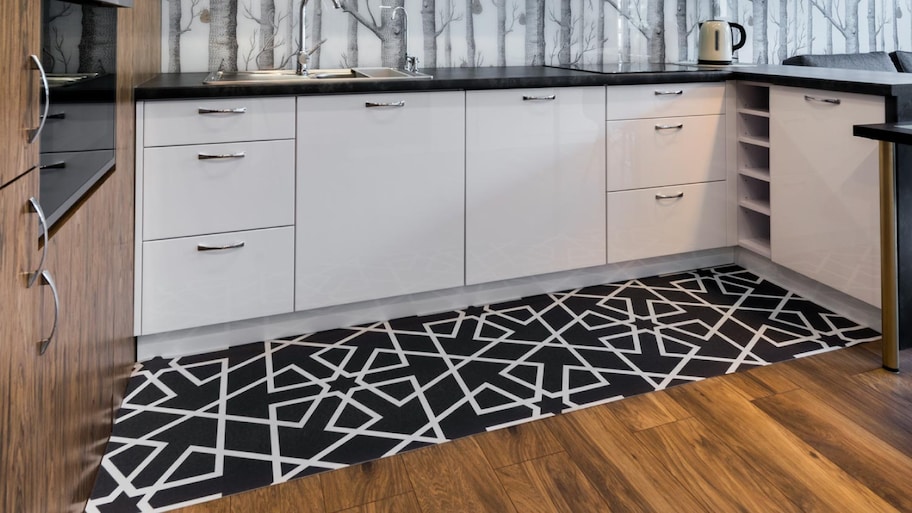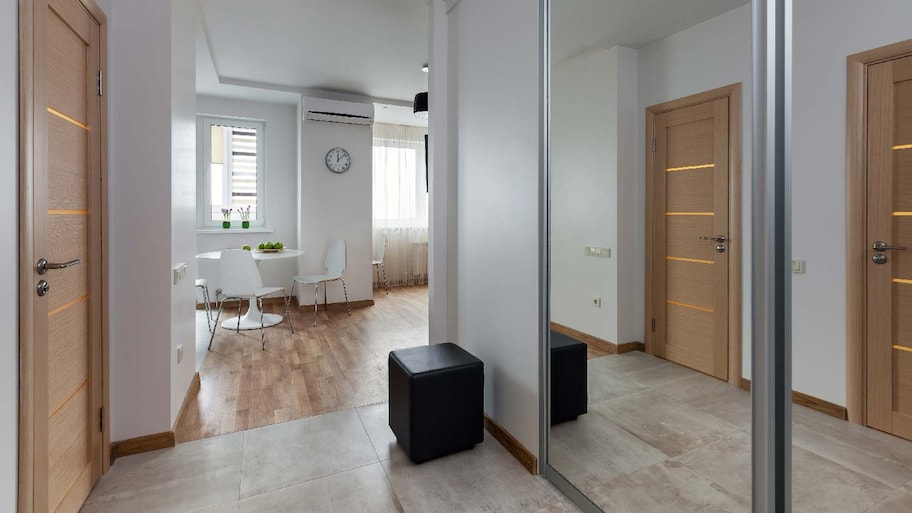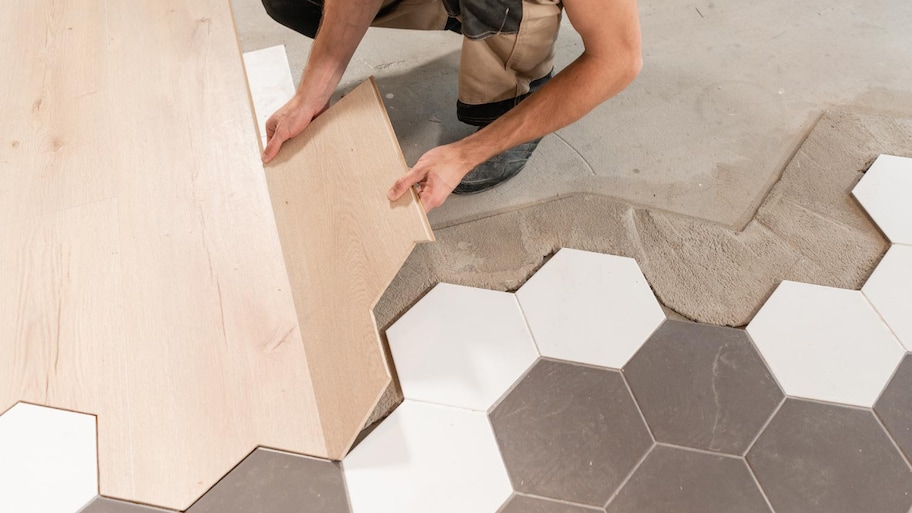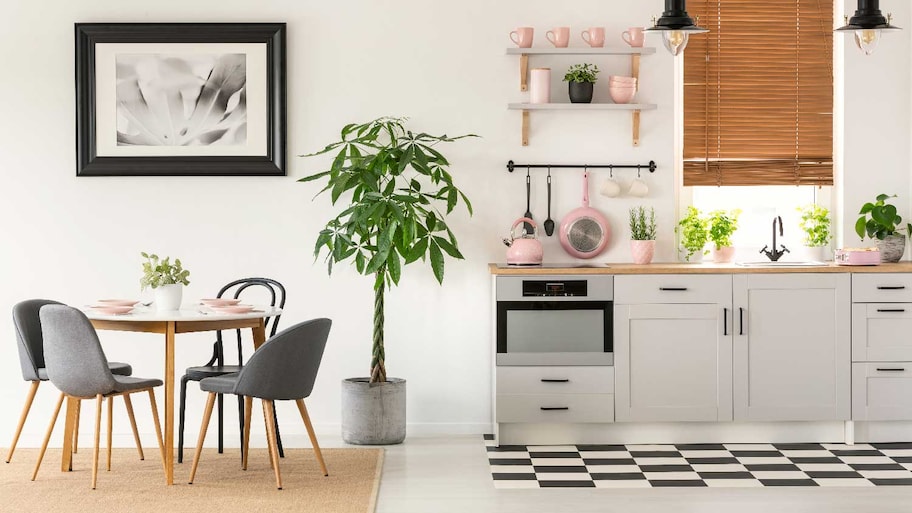8 Tips for a Beautiful Tile-to-Wood Floor Transition
Beautifully blend adjoining floors with these design ideas


Figuring how to transition two types of flooring seamlessly from one room to the next is a challenging home design task, especially if you’re working with an open floor plan without walls or other visual barriers to help divide the space. Transitioning between floors often requires contrasting materials and a healthy dose of creativity—but it’s a DIY project you can achieve with a few smart tricks. Follow these tips on how to make a tile-to-wood floor transition look seamless.
1. Create Contrasting Patterns
If you’re using two different flooring materials and wondering if you can mix tile and wood flooring, the answer is a resounding yes. However, there’s one key tip you’ll want to follow: If you have wood flooring in one room and are flowing into a space with ceramic tile, you’ll need to make sure the patterns don’t align (i.e., square tiles abutting square parquet flooring for example). Creating a differentiator in your flooring pattern—in this sense, the sizing of the hardwood planks or tiles—will give the sense of two entirely separate rooms while eliminating the jarring nature of the material change.
2. Make Sure the Tile and Hardwood Are Similar Height

Sometimes, it can be difficult to match the height between your tile and hardwood floors and make a smooth tile-to-wood transition, especially because of the mortar bed underneath the tile. The closer you can get in height, the better. Not only will your floors look more seamless, but they’ll be safer and more functional (aka preventing tripping). This is particularly important if you decide to do a carpet transition from wood flooring or tile.
Making the tile flush with the adjoining wood floor isn’t always possible, in which case you may want to incorporate a transition strip or reducer strip that acts somewhat like a ramp between the two materials. If you’re working with an existing wood floor and can’t find the product to match to build up to the level of the tile edge, you’ll need to use something more heavy-duty like end molding. If the unequal height difference is dramatic, consider a floating floor that doesn’t need to be nailed down or installing laminate flooring or engineered hardwood over the original wood floor.
3. Lay the Tile in a Different Direction From the Wood
If your hardwood floor planks run parallel to your home’s entryway, laying tile or another transitional flooring in the complete opposite direction—in this case, perpendicular to the wood floors—is a fun design mashup. You can go one step further and lay your tile out in a chevron pattern to give the room a modern feel while still visually breaking up the space with different flooring options.
Another classic example: If you’re using luxury vinyl flooring in your living room and opt for a checkerboard tile in your kitchen, you may choose to tile in a diamond pattern. This combination—instead of lining the tile edges up horizontally with the LVT—makes the room’s flooring design more striking and less linear.
4. Lace in the Two Floor Materials

One way to get creative with merging two different materials is by lacing the tiles into the existing wood flooring in what almost appears like an organic flow. This method is particularly effective when installing a new product or pattern in a kitchen, bathroom, or mudroom without swapping out or replacing the wood flooring that abuts it. It’s also a design that will likely require the skill of a local professional flooring company.
Pro tip: This flooring method is particularly effective when using a geometric pattern like a hexagonal tile. You can naturally weave it with the wooden flooring pattern without creating an abrupt transition from rectangle to rectangle.
5. Add a Transition Strip for Dramatic Effect
Using a floor transition piece or edge-protection profile protects your investment and provides the perfect finishing touch: a visual break between one flooring material and another. It’s subtle while also creating two distinct and separate spaces and keeping the eye trained on the actual star of the show: the flooring.
If you’re using a non-patterned flooring like a subway tile, you can also create your own transition by adding a single-tile border with the subway tile laid in the opposite direction as the wood floor, then build the main flooring pattern from this frame. Metal transition pieces come in varying sizes and styles, so you can always add one to your end project for a dramatic, high-end effect. Or you can go with a beautiful wood transition strip for a finished look.
6. Create a Tile Inlay
If you're putting a kitchen floor in the middle of a larger room with hardwood floors, you'll likely want to use tile because it handles moisture, drips, and stains better than wood. One way to do so without tearing out the entire existing floor is to create an inlay in the middle of the room where the kitchen is. To do this, leave the wood floor around the room's outer edges and carve out a square or rectangular space in the middle where the tile inlay will go. This works best with a contrasting tile design like a herringbone that draws the eye in and creates the appearance of two rooms in one.
7. Use a Different Tile Pattern as an Accent Border

In other instances, the best way to break up a wooden floor and tile transition in an open room is by adding a completely separate tile border as an accent piece between the two that also serves as a transitional edge. Accent border materials could be a glass mosaic tile or a simple subway tile that visually separates the wood and tile.
8. Use Contrasting Colors
If you’re using both a hardwood floor and a wood-look tile in the same space, it could appear a bit mismatched if you don’t make sure the colors are distinctly different. Consider using a bleached, faux wood tile for the replacement tile or, if your existing wooden flooring is the classic red oak tone, using a walnut-colored tile or a flat black is a nice way to create a contrast.
Have a tricky flooring project and aren’t sure how to transition from wood to tile? You may want to consider hiring an interior designer in your area to help you complete your project and achieve the just-right flooring transition for your space’s aesthetic.
